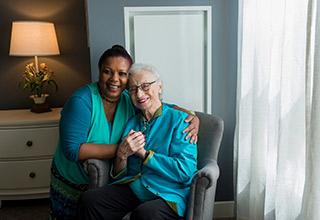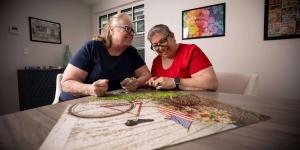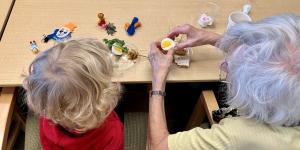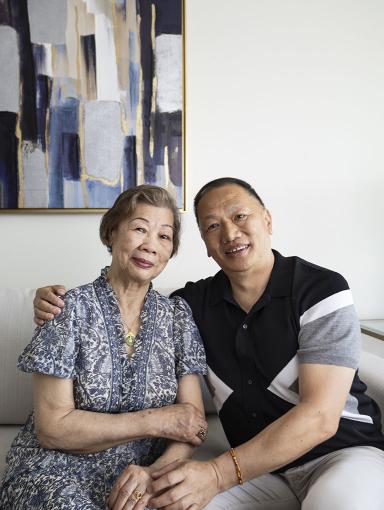The Joy of Movement: Unpacking the Benefits of Dancing for Seniors
Read about the ways dancing can boost your physical and mental well-being and how to get started.
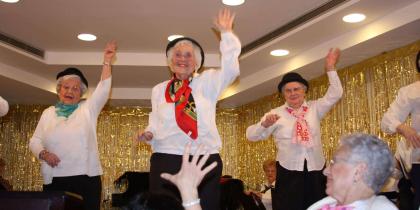
Art plays an integral role on Hebrew SeniorLife’s campuses. Music, arts and crafts, knitting, performances, and more come to life as patients and residents revisit art forms they loved earlier in life or try something for the first time.
Dancing is no exception. Dancing for seniors comes with many benefits, and the older adults at NewBridge on the Charles in Dedham, MA, and Hebrew Rehabilitation Center in Boston enjoy unique opportunities to stay active through intentional movement.
The science-backed benefits of dance for older adults
Dancing is more than just a fun and engaging exercise — it’s a powerful way to boost your physical and mental well-being. Many studies have highlighted how dancing later in life can improve your health, from improved memory and cognitive function to enhanced physical and emotional well-being.
Here’s what research shows about how dancing impacts older adults:
Better physical health
Like other forms of cardiovascular exercise, dance brings significant health benefits for older adults. A systematic literature review of 18 studies found that dance can improve muscular strength, endurance, balance, and cognitive function.
Another scientific literature review focused on participatory arts for older adults — participating in art rather than observing it. Overall, its findings highlight that dance is an effective way to support healthy aging in older adults. Studies included in the literature review found that older adults who dance socially show greater balance and gait than nondancers; additionally, dancing improves posture, reaction times, resting heart rates, and physical function scores.
A separate meta-analysis on how dance programs affect the physical performance of older adults found that dancing improves muscle strength, balance, and flexibility. It also noted that dancing is a safe and effective daily exercise for older adults to promote health.
Boosted cognitive function and mental health
A systematic review of how dance affects cognition in healthy older adults found that dancing can help maintain cognitive function. Factors contributing to that include the coordination required in dancing, socialization, music, and the ability to relieve symptoms of depression.
Another meta-analysis examined mind-body exercises like dance in older adults with mild cognitive impairment. It revealed that dance improved cognitive performance, alleviated depression, and decreased tau protein levels, a marker associated with dementia.
All in all, dance isn’t just a way to have fun — it’s a scientifically supported way for older adults to maintain their physical, cognitive, and mental health.
Dance as a path to healing and connection at Hebrew SeniorLife
At Hebrew SeniorLife, the joys of dancing are on full display. That’s thanks in part to the dedication and hard work of Iana Veselova and Whitney Peruzzi, LMHC, BC-DMT. Iana is a life enhancement coordinator at Hebrew Rehabilitation Center in Boston. She is also a professional dancer, certified ballroom dancing instructor, and choreographer. Whitney is the lead expressive therapist and therapeutic program manager for memory care assisted living at NewBridge on the Charles.
Each brings a unique approach, showcasing how dancing can positively impact older adults’ well-being.
Ballet and cultural connection for a Russian-speaking community
Iana’s educational ballet project, “20th Century Ballet,” at Hebrew Rehabilitation Center goes beyond traditional dance classes by combining movement with art, history, and storytelling.
Iana invites patients to explore classical ballets such as “Swan Lake” and “Giselle” by watching large-screen projections of ballet performances. She then discusses the history of the performance being shown and engages participants in gentle arm and leg movements that mimic the motions of the performance.

Iana’s deep passion for ballet has caused her to accumulate authentic memorabilia, including costumes, photographs, and vintage programs. Older adults can engage in these historical pieces to enhance their cultural connection and experience. “My goal is to teach something fresh every time. I bring original costumes so that the older adults can touch them. Not everyone interested in classical ballet can look at ballet costumes from original performances too closely,” she says.
While her ballet program was initially for Russian-speaking patients, she also teaches bilingual dance classes for larger groups. Dozens of participants attended her first outdoor bilingual dance class, and family members and staff were also in attendance. She has witnessed how dance impacts participants, who become visibly physically and emotionally relaxed. Many offer her kind words and thanks as they leave the class.
Additionally, in 2024, Iana launched a monthly Zumba program called “Free Movements” for older adults and staff members to unwind and dance together. This program allows patients and staff members to share lighthearted and joyful moments. It’s yet another example of how dance brings people together to create an emotionally enriching experience.
“It’s important to stop thinking that older adults — especially very old people — only need care. They do need care, but they still need life,” says Iana. She aims to provide that with her programs.
Dance/movement therapy for dementia
Whitney, a board-certified dance/movement therapist and licensed mental health counselor, often facilitates dance/movement therapy groups for memory support assisted living residents at NewBridge on the Charles. These groups are designed to improve the quality of life for residents living with dementia, Parkinson’s disease, and other neurocognitive disorders.
Sitting in a circle, the session starts with a warm-up to activate the body. After the warm-up, Whitney facilitates interventions designed to help participants increase awareness, form social connections, and address physical goals. From a giant balloon to ribbon wands and a colorful stretch band called the Octaband, there’s no shortage of tools to get people moving and having fun.
People living with dementia often have difficulty with verbal self-expression. One important goal of dance/movement therapy is to provide an outlet for non-verbal self-expression. Whitney observes how each resident moves to better understand their unique needs. She uses dance therapy techniques such as attunement, which involves connecting with participants by responding to their movements, and mirroring, which involves reflecting their movements, to build a therapeutic relationship with each participant. This helps build trust so participants feel more comfortable joining in expressive movement.
The group environment allows participants to foster a sense of community. “During the climax of the group, the goal is to have everyone moving together in rhythmic action, which builds a felt sense of connection and community,” says Whitney.
One memory of the impact of dance therapy stands out to Whitney. “After being actively engaged in a sequence of mind-body interventions, verbal expression may become more accessible. I often end my groups by asking, ‘What did you feel?’ and I will never forget the participant who was swaying with her arms wide open and responded: ‘Freedom,’” she says.
Advice for trying dance as an older adult
While the older adults in our care enjoy movement, you don’t have to be part of a senior living community or long-term chronic care facility to start dancing. You may be able to find dance classes specifically catered to older adults near you, but you can also dance at home!
There’s even research about the value of dancing at home for older adults. While a study found that dancing at home may lack some of the socialization and routine that you get from taking a class in person, it also found that both healthy older adults and older adults with Parkinson’s disease who participated in an at-home dance program reported benefits like improved posture, ease of movement, improved mood, and increased energy. In other words, at-home dancing can be a good alternative for individuals who can’t or would prefer not to attend an in-person dance class.
Whitney’s advice for getting started? “A lot of people shy away from the word dance. You can look at it as movement, exercise, or whatever feels more comfortable for you. Keep it low-pressure, and applaud yourself for trying something new! The benefits are worth it. The two most important goals are to move and to have fun,” she says.
If you’re caregiving for an older adult and think they may enjoy dancing, Whitney has advice for you, too. “Join them if you are able to! Usually, things are less intimidating to try if you’re not in it alone. After a few sessions together, they may have gained enough confidence and social support to continue on their own,” she advises.
Join the rhythm of a vibrant senior living community
Are you ready to leap into the next chapter of your life? Whether you’re considering moving into an independent living or assisted living community or are looking into long-term chronic care facilities and prefer an arts-focused touch, our expansive arts offerings have you covered.
If you’re interested in learning more about what we offer at Hebrew SeniorLife, we’re here to help. Connect with us online to learn more.
Join Our Community: Subscribe to the Hebrew SeniorLife blog for weekly insights on healthy aging and senior living.
Blog Topics
Learn More
Expressive Art Therapies
Using music, dance, and art, our expressive art therapists provide psycho-social support to seniors experiencing a wide range of issues, including adjustment to aging, health status changes, depression, and anxiety.
Long-Term Chronic Care
Hebrew Rehabilitation Center provides person-centered extended medical care in a homelike setting for patients with chronic illness. As a licensed long-term chronic care hospital, we provide higher-level, more comprehensive medical care to older adults than a traditional nursing home.
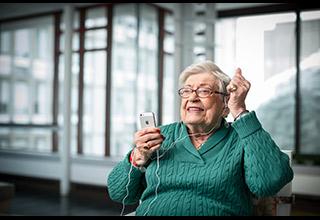
Memory Care Assisted Living
At NewBridge on the Charles in Dedham, MA, our memory care assisted living community was designed to address the needs of those with early- and mid-stage Alzheimer's disease or dementia.
